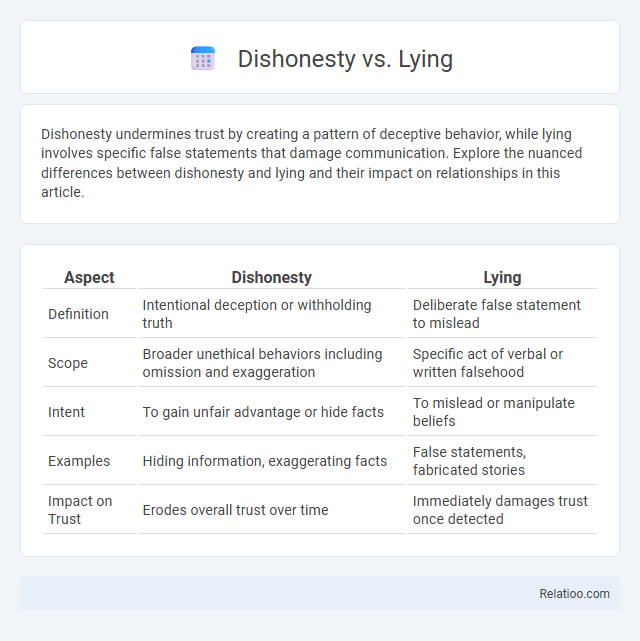Dishonesty undermines trust by creating a pattern of deceptive behavior, while lying involves specific false statements that damage communication. Explore the nuanced differences between dishonesty and lying and their impact on relationships in this article.
Table of Comparison
| Aspect | Dishonesty | Lying |
|---|---|---|
| Definition | Intentional deception or withholding truth | Deliberate false statement to mislead |
| Scope | Broader unethical behaviors including omission and exaggeration | Specific act of verbal or written falsehood |
| Intent | To gain unfair advantage or hide facts | To mislead or manipulate beliefs |
| Examples | Hiding information, exaggerating facts | False statements, fabricated stories |
| Impact on Trust | Erodes overall trust over time | Immediately damages trust once detected |
Understanding Dishonesty and Lying: Key Differences
Dishonesty encompasses a broad range of deceptive behaviors where truth is intentionally distorted or withheld, while lying specifically involves making false statements with the intent to deceive. Understanding the distinction is crucial: dishonesty can include omissions, exaggerations, or misleading actions, whereas lying is a direct verbal or written falsehood. Recognizing these nuances aids in identifying and addressing ethical breaches in personal and professional contexts.
The Spectrum of Deception: From White Lies to Fraud
The spectrum of deception ranges from harmless white lies, which are minor falsehoods intended to avoid hurt feelings, to outright fraud involving deliberate and malicious deceit for personal gain. Dishonesty encompasses a broad category of unethical behavior, including lying, withholding information, and misleading others, often varying in severity and intent. Understanding these distinctions highlights the complexity of deceptive acts and their implications for trust and ethical conduct.
Psychological Motivations Behind Dishonesty and Lying
Psychological motivations behind dishonesty and lying often stem from a desire to protect oneself from negative consequences, maintain self-esteem, or gain social approval. Dishonesty can include a range of deceptive behaviors, but lying specifically involves the deliberate communication of false information. Cognitive dissonance and fear of judgment frequently drive individuals to distort the truth, creating a complex interplay between conscious intent and subconscious influences.
Social and Cultural Perspectives on Dishonesty
Dishonesty encompasses a broader range of behaviors beyond lying, including deception, omission, and falsification, all of which carry varying social and cultural implications. Socially, dishonesty can erode trust, damage relationships, and undermine community cohesion, with cultural norms influencing the perceived severity and acceptability of these acts. Different cultures interpret dishonesty through unique ethical frameworks, where some may tolerate certain dishonest behaviors in specific contexts while strictly condemning others.
The Impact of Lying on Personal Relationships
Lying erodes trust and creates emotional distance in personal relationships, often leading to misunderstandings and resentment. Dishonesty, encompassing lying and other deceptive behaviors, undermines the foundation of communication and mutual respect essential for healthy connections. Your ability to foster strong, lasting relationships depends on honesty and transparency to build genuine trust.
Consequences of Dishonesty in Professional Settings
Dishonesty in professional settings undermines trust, damages reputations, and can lead to legal consequences or job termination. Unlike lying, which is a direct false statement, dishonesty encompasses a broader range of deceptive behaviors that erode workplace integrity. Your career growth depends on maintaining transparency, as repeated dishonesty disrupts team dynamics and compromises organizational success.
Spotting Dishonesty: Signs and Red Flags
Spotting dishonesty involves recognizing key signs such as inconsistent stories, avoiding eye contact, and nervous body language, which often indicate deceit. Lying specifically refers to intentionally providing false information, while dishonesty encompasses a broader range of deceptive behaviors including omission and exaggeration. Understanding these red flags helps you protect yourself from manipulation and build trust in your relationships.
Ethical Dilemmas: When Is Dishonesty Justified?
Ethical dilemmas involving dishonesty arise when the moral implications of lying conflict with perceived benefits, such as protecting others or preventing harm. Dishonesty, unlike simple lying, can include omission or misleading by concealment, complicating the assessment of ethical justification. Evaluating when dishonesty is justified requires weighing consequences, intent, and contextual factors against core principles of integrity and trustworthiness.
The Long-Term Effects of Chronic Lying
Chronic lying erodes trust and damages relationships, creating a cycle of suspicion that can take years to repair. Dishonesty not only harms your credibility but also impacts mental health, leading to increased stress and anxiety. Understanding the distinction between occasional lying and habitual dishonesty is crucial for addressing these long-term consequences effectively.
Building Trust: Overcoming Dishonesty and Restoring Integrity
Building trust requires consistently demonstrating honesty, as dishonesty erodes confidence and damages relationships. Overcoming lying involves acknowledging mistakes and committing to transparency to restore integrity. You can rebuild trust by fostering open communication and maintaining accountability in all interactions.

Infographic: Dishonesty vs Lying
 relatioo.com
relatioo.com